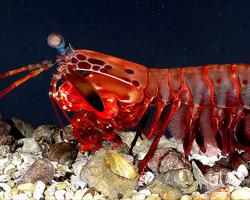
Váhy a míry
| Délka | od 3 do 18 cm |
|---|
Stav ohrožení
| Ohrožen |
Popis zvířete
The Peacock mantis shrimp, scientifically known as Odontodactylus scyllarus, is a fascinating marine crustacean that has captured the interest of scientists and nature enthusiasts alike due to its vibrant colors and unique physical and behavioral characteristics. Native to the warm waters of the Indo-Pacific region, from Indonesia to Guam, and from the north to Australia, this species thrives in the coral reefs and subtidal environments, where its remarkable features make it a formidable predator and an intriguing study subject.One of the most striking aspects of the Peacock mantis shrimp is its vibrant coloration. The body of this remarkable creature is a vivid mosaic of colors, with hues of bright green, blue, red, and orange that shimmer and change as the animal moves or as the viewing angle changes. This dazzling display is not just for show; it plays a crucial role in communication and possibly in mating rituals among these shrimps. The color patterns can convey various messages, such as warnings to potential predators or competitors and signals to potential mates.
The Peacock mantis shrimp typically grows to about 7 to 18 centimeters in length, though some individuals may reach lengths of up to 38 centimeters. Despite its common name, it is neither a shrimp nor a mantis, but a member of the order Stomatopoda, which is a separate group of crustaceans. Its body structure is quite distinctive, with a hard exoskeleton that provides protection against predators and environmental hazards. The exoskeleton is also molted periodically as the mantis shrimp grows.
One of the most fascinating features of the Peacock mantis shrimp is its eyes. These creatures possess some of the most complex eyes in the animal kingdom, capable of moving independently and seeing both polarized light and ultraviolet light. This extraordinary visual system allows them to detect prey, predators, and mates in the complex and colorful environment of the coral reef. Their eyes are mounted on mobile stalks and can rotate to provide a nearly 360-degree field of vision.
However, it is perhaps their hunting method that has made the Peacock mantis shrimp most famous. Equipped with two types of specialized appendages, called raptorial claws, they can strike with incredible speed and force. One type, known as "smashers," is used to deliver a powerful blow that can shatter the shells of crabs and snails or stun fish. The other type, "spearers," is equipped with sharp points to impale softer-bodied prey such as worms and squid. The speed of their strike is so fast (accelerating at over 10,000 g's) that it generates cavitation bubbles, which collapse with enough force to stun or kill prey even if the initial strike misses.
Beyond their striking physical attributes and hunting prowess, Peacock mantis shrimps are also known for their complex behaviors. They are solitary and highly territorial creatures, engaging in elaborate rituals to defend their territories. These rituals can include visual displays, using their vibrant colors, and physical confrontations. Interestingly, despite their aggressive nature towards other mantis shrimps and potential threats, they have been observed showing signs of complex social interactions and even monogamous pairings during breeding season.
The Peacock mantis shrimp's role in the ecosystem is significant. As predators, they help control the population of the prey species they hunt. Moreover, their unique characteristics make them a subject of interest in scientific research, particularly in the fields of materials science, robotics, and optical research, inspired by their armor and visual systems.
In conclusion, the Peacock mantis shrimp is a marvel of the natural world, combining striking beauty with fascinating biological and behavioral complexities. Its presence enriches the biodiversity of coral reef ecosystems, and its study can inspire advancements in technology and deepen our understanding of the natural world.
Nové fotografie zvířat
Top 10 zvířat
- Chinese water dragon (Physignathus cocincinus)
- Galápagos tortoise (Geochelone nigra complex)
- Dolphin gull (Leucophaeus scoresbii)
- Japanese macaque (Macaca fuscata)
- Colombian red howler (Alouatta seniculus)
- Sea urchins (Echinoidea)
- Moustached guenon (Cercopithecus cephus)
- Diana monkey (Cercopithecus diana)
- Common reed warbler (Acrocephalus scirpaceus)
- Common house mosquito (Culex pipiens)